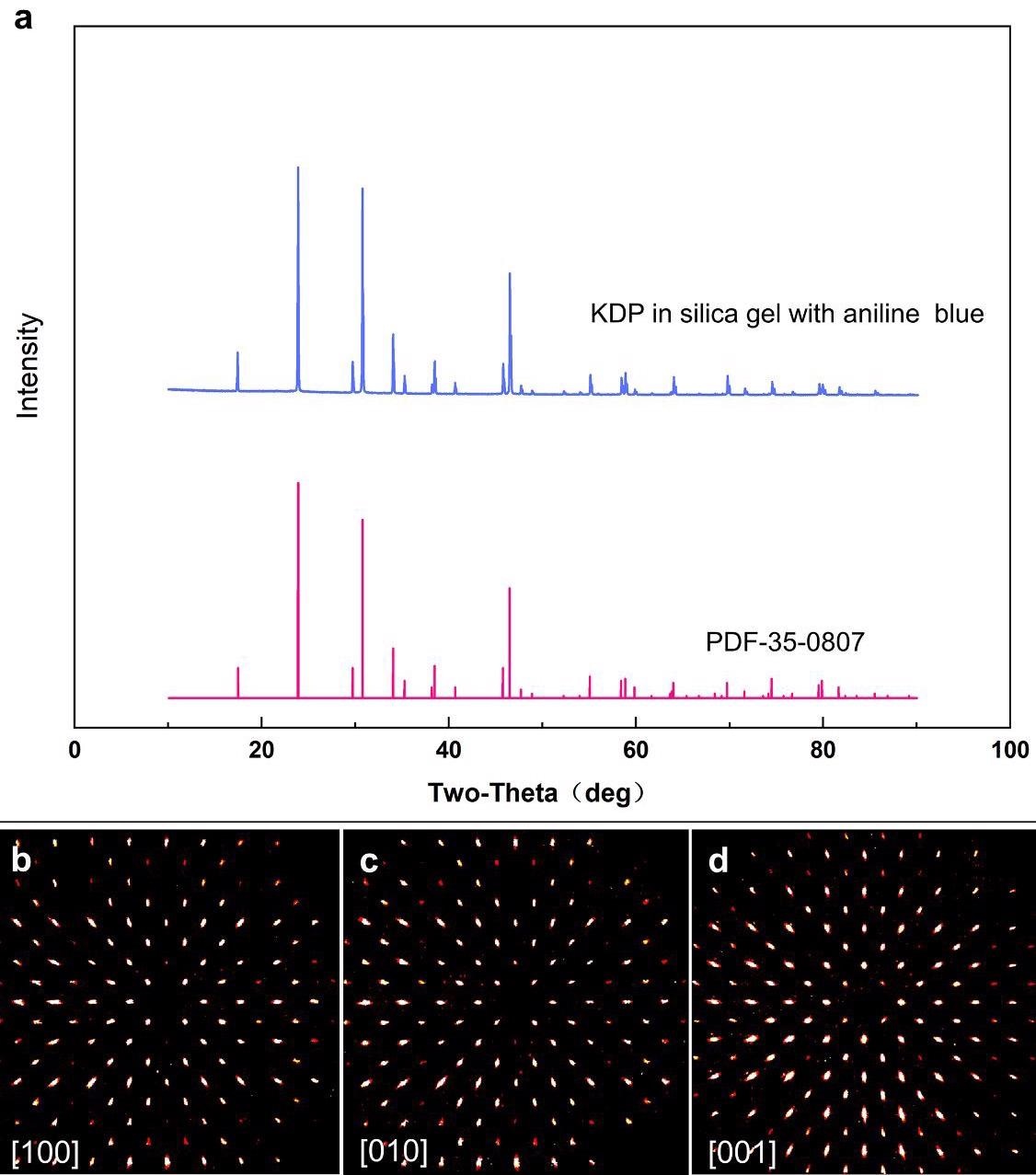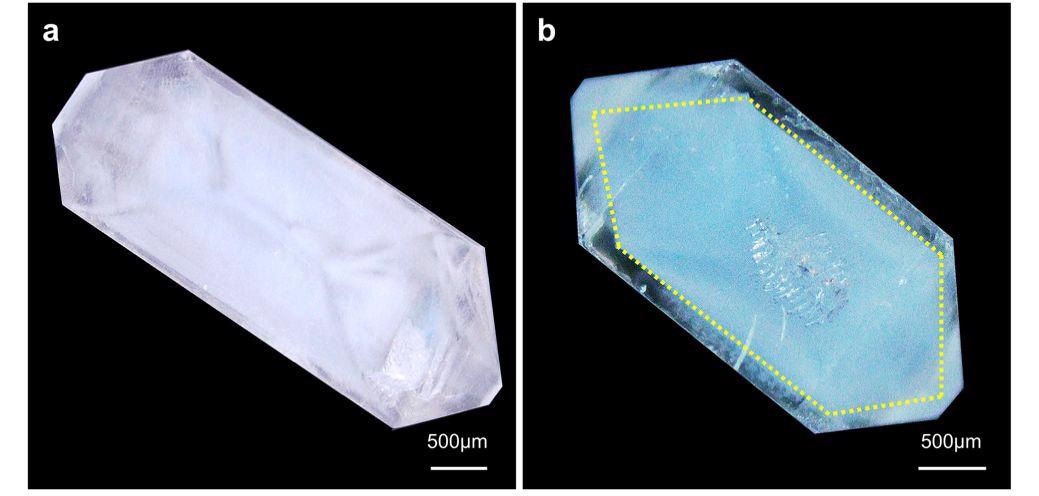Writing in the journal ACS Materials Letters, a team of scientists from Zhejiang University in China has reported the inclusion of dyes in nonlinear optical crystals using a gel-mediated strategy. The new research provides a strategy for facilitating the isotropic dyeing of single crystals and optimizing the properties of these crystals for advanced applications.

Study: Isotropically Dyed Single Crystals Produced via Gel-Incorporation. Image Credit: tj-rabbit/Shutterstock.com
Dye Inclusion Crystals
Incorporating dyes into transparent crystals is an ancient practice, with the ancient Egyptians dyeing alum and sea salt crystals with safflower and indigo extracts for ceremonial and religious purposes. However, it was not until the mid-19th century that the scientific study of dyeing crystals started properly.
Dyeing a crystal produces what is known as a dye inclusion crystal. Dye inclusion crystals allow researchers to study crystal growth mechanisms in-depth and have the potential for use in photonic and spectroscopic applications by modulating crystal properties.

OM images of the gel-grown KDP crystals incorporated with ALB molecules before (a), during (b) and after (c) dissolving the KDP. The bleaching of the blue color may be caused by the extraction of ALB from the residual gel block to the solvent, due to the high solubility of ALB. Image Credit: Gao, F et al., ACS Materials Letters
Nonlinear Optical Crystals
Dyeing transparent nonlinear optical crystals is an area of dye inclusion crystal research that has yielded applications in photonics and optoelectronics, such as optical communication, harmonic generation, and optical data storage. Dyeing nonlinear optical crystals modulates their mechanical, optical, and thermal properties.
Research has yielded doped nonlinear optical crystals with improved transmittance, third-order nonlinear optical susceptibility, and second harmonic generation efficiency. Doped nonlinear optical crystals include methylene blue-stained L-alanine and amaranth-doped potassium dihydrogen phosphate. Other dye modulated-nonlinear optical crystals have been produced with enhanced hardness, such as xylenol orange-doped dihydrogen phosphate.
Other crystals have been developed with enhanced thermal stability, such as sunset yellow-doped dihydrogen phosphate. Crystals such as Congo red-doped dihydrogen phosphate have displayed enhanced laser damage thresholds.
Research has indicated that the improved properties of these crystals are due to the dyes filling crystal vacancies. This optimizes the crystal structure and reduces defects within it. Moreover, dyes improve the electronic and optical properties of doped crystals, and improvements are aided by interactions between crystal hosts and doped molecules.

(a) PXRD patterns of gel-grown KDP crystals incorporated with both gelnetworks and ALB molecules(upper), and standard tetragonal KDP phase (PDF No. 35-0807). (b-d) Single-crystal-XRD spot patterns of a such KDP single crystal viewed from a-axis (b), b-axis (c) and c-axis (d). Image Credit: Gao, F et al., ACS Materials Letters
Current Challenges
There are challenges with doped-nonlinear optical crystals, however. Single crystals are anisotropic in nature, which leads to anisotropic dye incorporation due to electrostatic potentials varying with the crystal facets. This nonuniform incorporation limits the optical applications of dyed nonlinear optical crystals and further property improvements.
Isotropic binding interactions are a dye inclusion method that overcomes this anisotropic behavior. Nonspecific binding interactions are common in gel matrixes, and in biological organisms, biomacromolecules are incorporated in mineral crystals in biomineralization processes. Interconnected gel networks withstand crystallization pressure and lead to three-dimensional penetration of molecules.
Gel-mediated incorporation routes could potentially improve the dyeing process of nonlinear optical crystals. They can achieve a more uniform distribution of dye within the crystal matrix, but compared to anisotropic routes, the incorporation behaviors of dyes dissolved into single crystals using gel-mediated strategies are not clearly understood.
The Paper
The paper has investigated how to improve dye incorporation in single nonlinear optical crystals using a gel-mediated process. The research focused on preparing dihydrogen phosphate single crystals from silica gels containing aniline blue and methylene blue, two commonly used dyes that typically display anisotropic incorporation behavior in single crystals. Using a gel network strategy provided uniform distribution of dyes.
X-ray diffraction revealed no distinguishable interruption of the single-crystalline nature of the dye-incorporated nonlinear optical crystals. Furthermore, in the presence of gel networks, both dyes displayed increased incorporation contents. Raman spectroscopy and mapping confirmed the uniform distribution of the dye.
Gentle diffusion of methanol formed millimeter-sized crystals from the silica hydrogel used in the research. Crystals grown in solutions of aniline blue and methylene blue were prepared for comparison. Solution-prepared crystals displayed anisotropic and nonuniform dye inclusion. In comparison, the crystals prepared from dyed silica hydrogels displayed complete staining, with no notable anisotropic distribution.

OM images of KDP crystals grown from (a) solutions and (b) silica hydrogels containing methyl blue molecules. Image Credit: Gao, F et al., ACS Materials Letters
The authors investigated whether the gel networks were incorporated into the crystal structure along with dyes. This was evaluated using optical microscopy to monitor crystal dissolution processes. After dissolution in water, a solid residual blue block was left which had a shape consistent with the original crystal, indicating uniform silica gel network incorporation. The color of the block can be attributed to occluded dye molecules.
Incorporated methylene blue dye distribution inside the crystal was investigated using Raman spectroscopy. X-ray diffraction was employed to characterize the gel network and methylene blue-incorporation dihydrogen phosphate crystals.
Based on their results, the authors concluded that the isotropic gel network-mediation dye incorporation process facilitates the uniform distribution of methylene blue dye in single dihydrogen phosphate crystals.
The method demonstrated in the new paper provides significant advantages over conventional fabrication routes and has the potential to further optimize nonlinear optical crystal properties and inspire the future design of hybrid systems such as ternary organic solar cells.
Further Reading
Gao, F et al. (2022) Isotropically Dyed Single Crystals Produced via Gel-Incorporation ACS Materials Letters 4 pp. 1207-1213 [online] pubs.acs.org. Available at: https://pubs.acs.org/doi/10.1021/acsmaterialslett.2c00292
Disclaimer: The views expressed here are those of the author expressed in their private capacity and do not necessarily represent the views of AZoM.com Limited T/A AZoNetwork the owner and operator of this website. This disclaimer forms part of the Terms and conditions of use of this website.